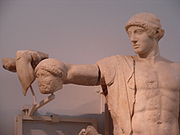
Apollon of Olympia
Encyclopedia

Pediment
A pediment is a classical architectural element consisting of the triangular section found above the horizontal structure , typically supported by columns. The gable end of the pediment is surrounded by the cornice moulding...
of the Temple of Zeus
Temple of Zeus
The Temple of Zeus at Olympia was an ancient Greek temple in Olympia, Greece, dedicated to the chief of the gods, Zeus. It was the very model of the fully developed classical Greek temple of the Doric order...
at Olympia. Its original location also provides it with another name: the Apollon from the west pediment. It is one of the most important statues of the Severe style
Severe style
The severe style, or Early Classic style, was the dominant idiom of Greek sculpture in the period ca. 490 to 450 BCE. It marks the breakdown of the canonical forms of archaic art and the transition to the greatly expanded vocabulary and expression of the classical moment of the late 5th century...
or early Classical
Classical sculpture
Classical sculpture refers to the forms of sculpture from Ancient Greece and Ancient Rome, as well as the Hellenized and Romanized civilizations under their rule or influence from about 500 BC to fall of Rome in AD 476. It also refers stylistically to modern sculptures done in a classical style....
style, dating from ca. 460 BCE
Common Era
Common Era ,abbreviated as CE, is an alternative designation for the calendar era originally introduced by Dionysius Exiguus in the 6th century, traditionally identified with Anno Domini .Dates before the year 1 CE are indicated by the usage of BCE, short for Before the Common Era Common Era...
. The statue is currently in the archaeological museum in Olympia.
The sculptures of the west pediment depicted the battle of the Lapith
Lapith
The Lapiths are a legendary people of Greek mythology, whose home was in Thessaly, in the valley of the Peneus and on the mountain Pelion.They were an Aeolian tribe. Like the Myrmidons and other Thessalian tribes, the Lapiths were pre-Hellenic in their origins...
s against the Centaur
Centaur
In Greek mythology, a centaur or hippocentaur is a member of a composite race of creatures, part human and part horse...
s, following the wedding feast of Peirithous and Hippodamia
Hippodamia (wife of Pirithous)
Hippodamia and δαμάζειν damazein , "Tamer of horses"; also known as Deidamia ), daughter of Atrax or Butes, was the bride of King Pirithous of the Lapiths. At their wedding, Hippodamia, the other female guests, and the young boys were almost abducted by the Centaurs. Pirithous and his friend,...
. The battle of the Lapiths - legendary inhabitants of Thessaly
Thessaly
Thessaly is a traditional geographical region and an administrative region of Greece, comprising most of the ancient region of the same name. Before the Greek Dark Ages, Thessaly was known as Aeolia, and appears thus in Homer's Odyssey....
- against the Centaurs - wild forest inhabitants with a human upper half and the body of a horse - frequently acted as a mythological metaphor for the conflicts between the Greeks
Ancient Greece
Ancient Greece is a civilization belonging to a period of Greek history that lasted from the Archaic period of the 8th to 6th centuries BC to the end of antiquity. Immediately following this period was the beginning of the Early Middle Ages and the Byzantine era. Included in Ancient Greece is the...
and the Barbarian
Barbarian
Barbarian and savage are terms used to refer to a person who is perceived to be uncivilized. The word is often used either in a general reference to a member of a nation or ethnos, typically a tribal society as seen by an urban civilization either viewed as inferior, or admired as a noble savage...
s. Most of the figures in this turbulent battle scene were discovered during the German excavations of 1875, led by the archaeologist Georg Treu
Georg Treu
Georg Treu was a classical archaeologist and director of the Skulpturensammlung of classical sculpture in the Albertinum in Dresden. He also led the 1875-1881 German excavations at Olympia.-External links:...
.
The juvenile Apollo stood in the centre of the pediment, directing his gaze toward the Lapiths. With his outstretched right arm, he seemed to order an end to the iniquity: the Centaurs had betrayed the Lapiths' hospitality, drunk to excess, and kidnapped their women. Nevertheless, his inclusion appears to be merely figurative; the combatants seem ignorant of his presence, with no other figure in the pediment referring, either in their motion or gesture, to the appearance of the god.
The back of the sculpture, which had not been visible to viewers, is notable for being more roughly worked than the front. This difference has provided modern scholars with information on the methods used by Ancient Greek sculptors, and contributed to the debate regarding whether the later Hermes of Olympia is an original Greek sculpture, or a Roman copy.
External links
- Apollo (Olympia, Temple of Zeus, c. 460) - a photograph of the sculpture.
- * Virtuelles Antikenmuseum Göttingen

